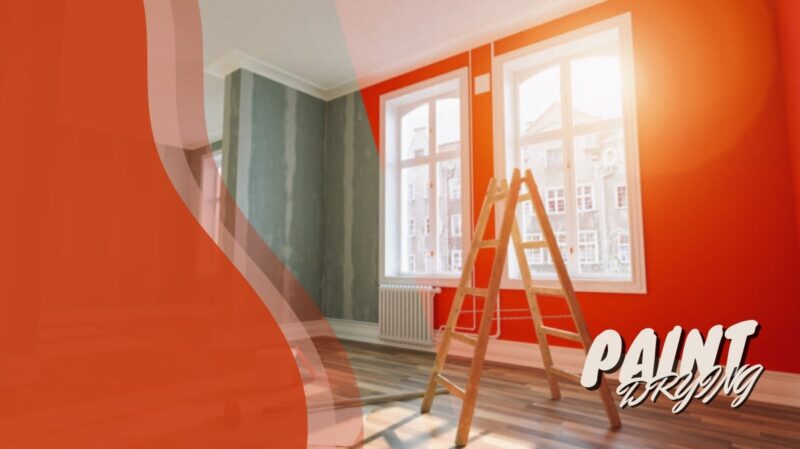Picture this: You’ve just finished painting your room a beautiful new color, and you’re eager to put everything back in its place. But wait – how long should you wait before moving your furniture back in? You don’t want to risk damaging your freshly painted walls or your valuable furniture. In this comprehensive guide, we’ll explore the factors that determine how long paint takes to dry and provide expert tips to help you achieve a perfect paint job. So, let’s dive in!
The Science Behind Paint Drying
A Brief Overview
Before we get into the specifics of drying times, it’s essential to understand the science behind paint drying. It dries through a process called “curing,” which involves the evaporation of water or solvents and the hardening of the paint film. There are two stages to this process: surface drying and through drying.
Surface Drying vs. Through Drying
Surface drying occurs when the paint becomes dry to the touch, and it generally takes a few hours. However, just because it feels dry doesn’t mean it’s ready for furniture. Through drying, also known as curing, takes much longer and is the point at which the paint has reached its full hardness and durability.
Factors Affecting Drying Time
Several factors influence how long paint takes to dry, including the type you are using, the number of coats applied, and environmental conditions. Let’s take a closer look at these factors.
Type
The two most common types of paint are water-based (latex) and oil-based (alkyd). The water-based type generally dries faster, with a drying time of around 2-4 hours for surface drying and 24-48 hours for through drying. Oil-based paints, on the other hand, require a longer drying time, with surface drying taking 6-8 hours and through drying taking 48-72 hours.
Number of Coats
The more coats of paint are applied, the longer it takes for the paint to dry. Each additional layer adds to the overall drying time, so be sure to factor this in when planning your painting project.
Environmental Conditions
Temperature, humidity, and air circulation all play a crucial role in paint drying times. Paint dries more quickly in warm, dry conditions with good air circulation. High humidity levels or low temperatures can significantly increase drying times, so keep this in mind when planning your painting project.
Expert Tips for a Perfect Paint Job
Now that we understand the factors affecting drying times let’s explore some expert tips to ensure your paint job is flawless.
1. Choose the Right Paint
Select a high-quality paint that suits your specific needs, whether you’re painting indoors or outdoors, on wood or drywall. High-quality products often have better adhesion and coverage, which can help reduce the number of coats needed and shorten drying times.
2. Prepare Your Surfaces
Properly preparing your surfaces can make a world of difference in the final result. Clean the surfaces thoroughly, repair any damages, and use a suitable primer for the best possible adhesion.
3. Plan Your Painting Project
Plan your painting project with ample time for each step, including surface preparation, application of multiple coats, and drying time. Don’t rush the process – giving each coat enough time to dry will result in a better, more durable finish.
4. Monitor Environmental Conditions
Keep an eye on the temperature and humidity levels in your painting area, and adjust your painting schedule as needed. It’s also a good idea to ensure good air circulation by using fans or opening windows, but avoid creating drafts that can cause debris to stick to the wet paint.
5. Follow the Manufacturer’s Guidelines
Always read and follow the manufacturer’s guidelines for drying times, as they will provide the most accurate information for their specific product. Some paints may have additives or specialized formulas that affect drying times, so it’s essential to follow the instructions on the can.
When Can You Put Furniture Back?

Now that we’ve covered the factors affecting drying times and shared some expert tips, let’s answer the million-dollar question: When can you safely move your furniture back in?
1. For Water-Based (Latex) Type
As a general rule, wait at least 24 hours after applying the final coat of water-based paint before moving furniture back into the room. However, if it is still tacky or soft to the touch after 24 hours, wait another day to be on the safe side. Remember that drying can take up to 48 hours, so it’s essential to be patient.
2. For Oil-Based (Alkyd) Type
Oil-based paints require a longer drying time, so wait at least 48 hours after applying the final coat before moving your furniture back in. If the paint still feels soft or tacky after 48 hours, give it another day or two before putting the furniture back.
3. For Heavy or Large Furniture
When moving heavy or large furniture, it’s a good idea to give the paint a little extra time to cure fully. Consider waiting 72 hours or more to ensure that it has reached its maximum hardness and durability. This will minimize the risk of damage to both the paint and your furniture.
4. Keep It Light
When you’re finally ready to move your furniture back, take care to avoid scraping or bumping the walls. Use felt pads or furniture sliders to protect your freshly painted surfaces and make moving heavy items easier. It’s also a good idea to enlist the help of a friend or family member to help you move the furniture safely.
Final Words
A freshly painted room can breathe new life into your home, but it’s essential to give the paint ample time to dry before moving your furniture back in. By understanding the factors that affect drying times and following our expert tips, you can ensure a perfect paint job that will stand the test of time.
Remember that patience is key – waiting a little longer for it to dry fully will pay off in the long run, as your walls will be more durable and less prone to damage.

